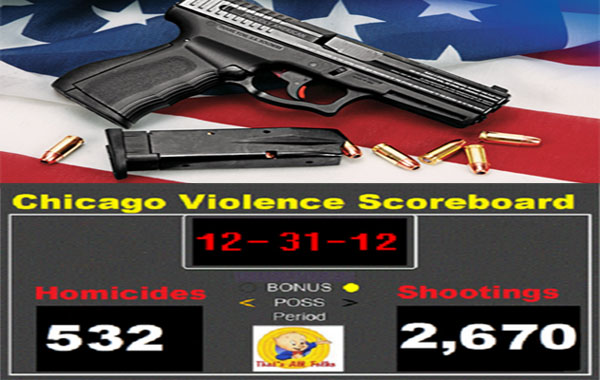
532 Murders In Chicago Show Gun Bans Donít Work
Truther
The mayor of what is at once America’s most gun-controlled city and its murder capital wants an assault weapons ban like the one he pushed in 1994. Except it didn’t work then, and it won’t work now.
Nathaniel T. Jackson, 40, an alleged gang member with a long arrest record, was gunned down last week outside a store in Chicago’s Austin neighborhood, becoming the Windy City’s 532 murder victim in 2012.

Up to 80% of Chicago’s murders and shootings are gang-related, according to police. By one estimate, the city has almost 70,000 gang members. A police audit last spring identified 59 gangs and 625 factions; most were on the South and West sides.
Yet, in the view of Chicago’s mayor and former White House Chief of Staff Rahm Emanuel, the answer to violence by crazies and criminals in his city and nationally is more gun control, not more gang and goon control.
“As somebody who stood by President Clinton’s side to make sure we had a ban on assault weapons, I do not want to see more weapons on the street, more guns on the street,” Emanuel said at a Chicago Police Department graduation and promotion ceremony on Dec. 17, shortly after the tragedy at Sandy Hook Elementary School in Newtown, Conn.
“It’s time that we as a city have an assault weapons ban. It’s time that we as a state have an assault weapons ban. It’s time that we as a country have an assault weapons ban,” Emanuel said.
The problem is that Emanuel’s ban, in place from 1994 to 2004, had no measurable effect on crime.
Statistics compiled by a Northeastern University professor, the Census Bureau and the Milwaukee Journal Sentinel show the number of mass shootings and victims from 1976 to 2010 has fluctuated annually, but without any major upward or downward trend.
Some 2,956 people have been killed in 646 mass shootings over this 35-year period, with a mass shooting defined by the FBI as one in which four or more people (not including the shooter) are killed in a single incident and typically in a single location. FBI homicide data show no discernible trend in the number of mass shootings or victims during that time.
A chart using these data and published in the Journal Sentinel does show that while the Clinton/Emanuel assault weapons ban was in place, from 1994 to 2004, mass shootings actually rose slightly and that after its repeal there was no precipitous rise, as supporters had warned.
“You had that for 10 years when Dianne Feinstein passed that ban in ’94. It was on the books. Columbine occurred right in the middle of it (April 20, 1999). It didn’t make any difference,” NRA chief Wayne LaPierre argued in a recent appearance on NBC’s “Meet The Press,” where host David Gregory may have violated the law himself by possessing and waving before the cameras a high-capacity ammunition clip.
What has had an effect on crime, and even mass shootings, is the rise in the number of concealed carry states from only a handful 25 years ago to some 41 now. Major crimes, except in gun-controlled major cities, have shown a continuing decline that has paralleled the rise in the number of right-to-carry states.
Maybe Mayor Emanuel, instead of calling for a new assault weapons ban, should call on Illinois to become a concealed carry state.
http://www.pakalertpress.com/2013/01/04/532-murders-in-chicago-show-gun-bans-dont-work/
